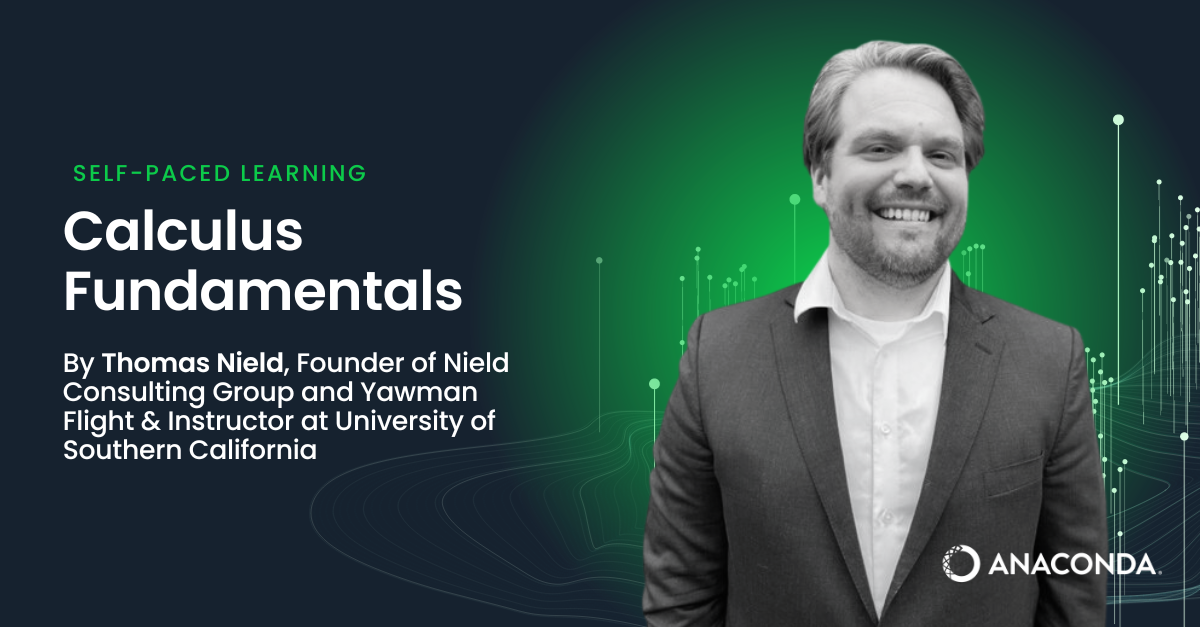- Getting Started
-
How to use Anaconda Notebooks 00:01:02
-
Course Overview and Learning Objectives 00:02:46
- SymPy Basics and Functions
-
Number Theory 00:11:59
-
SymPy Basics 00:09:19
-
Functions, Exponents, and Logarithms 00:08:01
-
Exercise: Using SymPy 00:01:40
- Limits
-
Approaching Infinity 00:04:27
-
Introducing Limits 00:07:20
-
Euler's Number 00:10:05
-
Exercise: Solve the Limit 00:01:46
- Derivatives and Partial Derivatives
-
Secant and Tangent Lines 00:08:34
-
Derivatives 00:03:40
-
Partial Derivatives 00:05:32
-
Exercise: Calculate the Slope 00:01:55
- Gradient Descent
-
Understanding Gradient Descent 00:06:05
-
Simple Gradient Descent 00:13:25
-
Multivariable Gradient Descent 00:06:34
-
Gradient Descent for Linear Regression 00:09:45
-
Stochastic Gradient Descent 00:03:19
-
Exercise: Minimize the Function Loss 00:01:39
- Integrals
-
Discovering Integration 00:04:20
-
Reimann Sums 00:07:50
-
Normal Distribution Example 00:03:28
-
Exercise: Find the Area 00:01:17
- Conclusion
-
Summary and Further Reading Resources 00:02:55
-
End of Course Survey

Calculus Fundamentals
Discovering calculus with SymPy.
Calculus is often perceived as a subject learned in high school and college, with limited real-world application. However, with the democratization of statistics and machine learning at the workplace, learning calculus has become increasingly relevant for professionals working with and modeling data. Calculus plays a crucial role in understanding probability distributions through integrals and is imperative to various machine learning techniques, including neural networks, where derivatives are used for gradient descent. The core principles of "learning" in machine learning are in fact rooted in calculus.
In this hands-on course, we will adopt a different approach from traditional high school or college classes to learn fundamental calculus concepts. We will use Python with the aid of SymPy, a powerful symbolic math library. Starting with a review of basic functions, you’ll learn about limits, derivatives, and integrals. Along the way, you’ll be provided with opportunities to apply these concepts to practical examples, such as fitting a linear regression using gradient descent and finding probabilities under a normal distribution.
By the end of this hands-on course, you’ll understand:
- Fundamental concepts of limits, derivatives, and integrals
- How calculus applies to machine learning and statistical tools
- The nature of functions in modeling data
And you’ll be able to:
- Use SymPy to automate “pencil and paper” mathwork in Python
- Conceptualize limits to derivatives, integrals, and gradient descent
- Connect the theory of calculus to actual practice
This training is for you because...
- You are a data science professional looking to better understand the fundamentals of calculus.
- You work with data scientists and machine learning practitioners who frequently use mathematical models in their daily work.
- You wish to become a better machine learning practitioner by understanding the role of calculus in machine learning.
Prerequisites
- Proficiency with basic Python operations, including variables, loops, collections, functions, and other basic operations.
Setup
To open Anaconda Notebooks:
- Go to https://anaconda.cloud
- Click on 'Notebooks' from the top navigation menu
- Create an account or login if you already have one
Recommended preparation
- Introduction to Python Programming learning path
Recommended follow-up
- Statistics and Hypothesis Testing on-demand course
- Linear Algebra on-demand course
- Probability Fundamentals on-demand course
Facilitator bio
Thomas Nield is the founder of Nield Consulting Group and Yawman Flight, as well as an instructor at University of Southern California. He enjoys making technical content relatable and relevant to those unfamiliar or intimidated by it. Thomas regularly teaches classes on data analysis, machine learning, mathematical optimization, and practical artificial intelligence. At USC, he teaches AI System Safety, developing systematic approaches for identifying AI-related hazards in aviation and ground vehicles. He's authored three books, including Essential Math for Data Science (O’Reilly) and Getting Started with SQL (O'Reilly).
He is also the founder and inventor of Yawman Flight, a company developing universal handheld flight controls for flight simulation and unmanned aerial vehicles. You can find him on Twitter | LinkedIn | GitHub | YouTube.
Questions? Issues? Contact [email protected].



